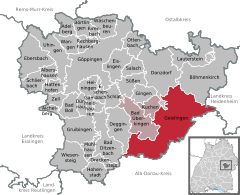Geislingen an der Steige
| Geislingen an der Steige | ||
|---|---|---|
| ||
 Geislingen an der Steige Location of Geislingen an der Steige within Göppingen district   | ||
| Coordinates: 48°37′28″N 9°49′50″E / 48.62444°N 9.83056°ECoordinates: 48°37′28″N 9°49′50″E / 48.62444°N 9.83056°E | ||
| Country | Germany | |
| State | Baden-Württemberg | |
| Admin. region | Stuttgart | |
| District | Göppingen | |
| Government | ||
| • Mayor | Frank Dehmer | |
| Area | ||
| • Total | 75.83 km2 (29.28 sq mi) | |
| Elevation | 464 m (1,522 ft) | |
| Population (2017-12-31)[1] | ||
| • Total | 28,021 | |
| • Density | 370/km2 (960/sq mi) | |
| Time zone | CET/CEST (UTC+1/+2) | |
| Postal codes | 73301–73312 | |
| Dialling codes | 07331, 07334, 07337 | |
| Vehicle registration | GP | |
| Website | www.geislingen.de | |
Geislingen an der Steige is a town in the district of Göppingen in Baden-Württemberg in southern Germany. The name relates to its location "on the climb" (an der steige) of a trade route over the Swabian Jura mountain range.
History
Although the area had settlements since the Bronze Age, Geislingen was founded by the counts of Helfenstein as a transit collection station on the important commercial route between the Rhine valley and the Mediterranean. The fortified Helfenstein castle existed since 1100. Giselingen was first mentioned as civitas in a document dated 1237. From 1396 through 1802, Geislingen was owned by the free and imperial city of Ulm on the Danube. In 1803 Ulm and Geislingen became part of Bavaria, but in a land exchange were incorporated into the Kingdom of Württemberg in 1810.
Industrialization started with the arrival of the railroad and the construction of the Fils Valley Railway (1847-1850) up the Geislinger Steige, a steep incline of rail and road to the plateau of the Schwäbische Alb (Swabian Jura), and Geislingen (Steige) station. The leading industrial enterprise is the Württembergische Metallwarenfabrik (WMF) founded in 1852, a world-renowned manufacturer of goods for kitchen and table.
Main sights
Notable births
Sons and daughters of the city
- Michael Knoll, (1805-1852), railway engineer, Oberbaurat, builder of the Geislinger Steige
- Bernhard Ilg (b. 1956), politician (CDU) and Lord mayor of Heidenheim since 2000
- Karl Allgöwer (b. 1957), football player
- Andreas Buck (b. 1967) football player
- Andreas Frey (b. 1967), economist and rector
- Markus Gisdol (b. 1969), football player and coach
- Martina Schumacher (b. 1972), painter and conceptual artist
Partnership
Geislingen is twin town of:
References
- ↑ "Bevölkerung nach Nationalität und Geschlecht am 31. Dezember 2017". Statistisches Landesamt Baden-Württemberg (in German). 2018.
External links
